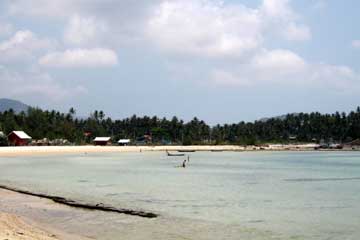March 31, 2007
Northeast Coast of Malaysia
To view a slideshow from northern
Malaysia, press HERE.
The Mosque in Kota Bharu 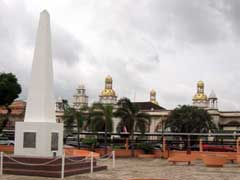 |
The Cultural Center in Kota Bharu 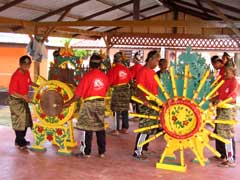 |
W.C. Signs  |
We arrived in Kota Bharu on Thursday the 22nd of March. We quickly discovered that Northeast Malaysia is not as tourist-friendly as the rest of Southeast Asia. It was nearly impossible to find reasonably priced accommodations. At the budget end there is nothing between a hotel and backpacker place. Both the backpacker and budget hotels are dirty and dingy, often with overwhelming mold and mildew in the rooms. The cheapest hotel with hot water, AC, and TV cost about $18 per night. The AC is an essential now with daily highs in the 90’s and super-high humidity. We were lucky to get a room without the mildew and only slightly dingy for $16.50 per night. It took me hours of looking to find it. I could only shake my head, because we had rooms that was twice as nice in Thailand for $14 per night just 350 kilometers to the north in Nakhon and 200 km in Songklha. Additionally, this is a country where they want to be paid upfront, unlike the rest of SE Asia. One thing that was very welcoming was the A&W restaurant. There is nothing like a root beer float to help you for get the heat and remind you of home.
It was clear on Thursday, when we arrived, that Kota Bharu was a Muslim city and it became even clearer on Friday. Like the many states in the US in the 1950’s, almost everything closes on the holy day, which in the case of Islam is Friday. Like our blue Sundays, they have blue Fridays – meaning most everything is closed. We did explore the town a bit on Friday. We ate lunch at a Chinese restaurant. 40% of the Malaysians are ethnically Chinese. We got oriented as to where most of the museums and centers were. In the evening we discovered the night food market with its many stalls serving all kinds of food. One of my favorites was the banana pancake. The grilled chicken is very good too. We were able to eat a big, good tasting meal for less than one dollar each.
On Saturday, we visited two museums. They were OK. The better of the two is the Isanta Jahar. An isanta is the residence of a sultan. Yes the local rulers are called sultans. It had an excellent display of cloth, costumes and artifacts of life in the area from the not too distant past. The collection of weapons in the royal armory was really good too. Another thing that I learned at both museums was that 30 years ago the Muslim head scarf and long, flowing dresses may not have been common at all. It was not until we saw photos taken in the 1980’s that women began to wear them. Now they are ubiquitous. And women seem to be the ones to bear the outward appearance of their religion. The men rarely could be identified as Muslim from there appearance. Only the very occasional copa (a white cotton beanie cap) said “I am a Muslim man.” Betty took some interesting pictures showing where toilet signs were the drawings of Muslim dress.
We saw more of the museums on Saturday. We visited a great little curry house, called Meena Curry. The food was served on a banana leaf. The proprietor was friendly and very kind. After lunch, we rested before going to the local cultural center. At the center we heard traditional music and saw a demonstration of top throwing and dance.
On Sunday, the 25th, we traveled by bus to Kuala Terengganu, three hours and 165 km. Looking for accommodations again proved to be very frustrating with more low-grade hotels (read small, dirty, dingy, mold filled rooms) at very high costs and no guesthouses. I even tried visiting Malaysian tourist information office. They were of little to no help. They would like Malaysia to be more tourist-friendly. In this they have their work cut out for them. Having visited only two cities, I am of the opinion that the government could really help tourism here by putting money into the local affiliate of the International Youth Hostel Association. Try to encourage the building of new, clean facilities for young people and budget travelers. Finally, we found one that was just acceptable. Then we walked to the local Chinatown for an excellent meal.
The next day was very difficult. Another very tourist-unfriendly situation presented itself to us. Despite its size, Terengganu does not have a local bus system. I made the mistake of not hiring a taxi to take us to the premier museum of Malaysia. We thought that it was only three kilometers from the center, but it was almost twice that. So we walked and walked in the sun and the heat. It was just too much walking all the way to the State Museum. The State Museum is a big, beautiful museum. The most significant bricks and mortar yet. We expected to see a tremendous lot of things, but in reality there was not that much to see. We took our time. We had lunch there. We saw little bit more. When we were ready to go back tp our hotel, we asked about transportation. Of course, there was none. Someone called a taxi service. According to the information sheet from the museum fares are a little over $2. One the phone the taxi driver asked if I knew the fare. I said: yes, the fare is 7 RM. No, says he, it is 15 RM. At which point I hung the phone up. There are no meters on the taxis, so they can charge what they want. We waited and within twenty minutes we secured a ride back into the city from one of the many folks who worked there. Four or five kilometers back in the center, we took the time to see the White Mosque and the Insanta Maziah. The White Mosque is truly beautiful. We also saw a bit of the waterfront and central market.
On Tuesday we rode the bus to Cherating. To get there we bypassed the popular islands and turtle nesting grounds that many tourist visit. Cherating is a beautiful stretch of beach, just 45 km north of Kuantan. Remarkably it has reasonably priced accommodation right on the beach. It felt like a great place to be. And so we stayed, doing very little and just enjoyed the quiet beach scene. We stayed the rest of the week. Mostly Malaysian families come here from as far away as Kuala Lumpur, which is more than 200 kilometers away. On Friday, all the little beach bungalows started to fill up. We asked the couple staying in the one next to us if they were from KL. They were going back on Sunday, and so we asked to ride with them, to which they graciously agreed. We continue to find the Malaysians incredibly friendly.
The beach is very inviting, being a very broad, near-perfect strand of the softest and whitest sand. Everyday we swam and enjoyed the sun. Well, we tried to enjoy the sun. When it is out it gets very hot. But if it is overcast, like today, it is not so hot. The water is warm and very clean. You can walk out on the smooth sandy bottom for more than 100 meters. I could not have picked a more idyllic place to hangout, but, in truth, it was just luck that we happen upon Cherating. If you are ever on the east coast of Malaysia, then stop here for a few days of rest and relaxation.
Here I Am in the Water at Cherating Beach
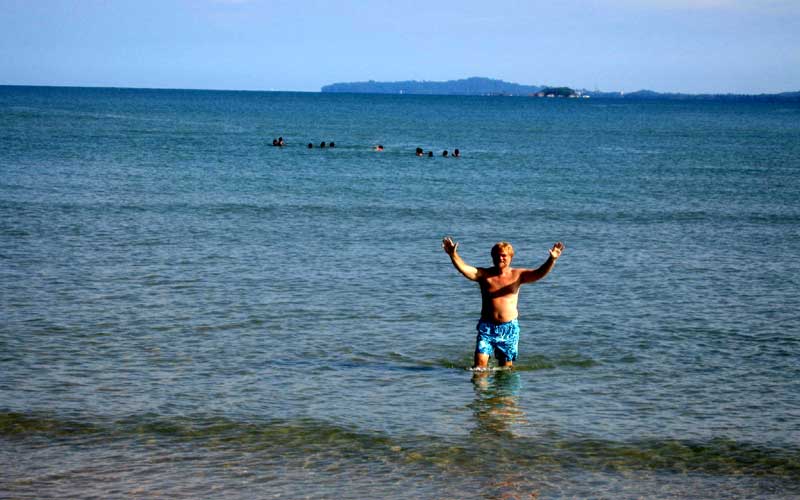
March 22, 2007
The Deep South of Thailand
Saint Patrick’s Day, 2007:
The joy was palpable when we reached Nakhon Si Thammarat. Despite the heat the people are very friendly here, quite a change from the islands. We were greeted with more big smiles than we have seen anywhere in Thailand. As for the heat, hot and humid is the rule here. We have to go in for a siesta in the afternoon because it must be in the 90’s or over 32 c. The hotel we are staying at is modern with all the necessary amenities and plenty reasonable. The only set back was that we did not make it to an Irish Bar.
To view a slideshow from southern
Thailand, press HERE.
Nakhon Si Thammarat Sights  |
Pier in Songkhla  |
Mosques and Wats in Songkhla  |
Monkeys in Songkhla  |
Hat Narathat Fishing Village 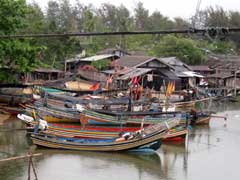 |
Details, Generality, and Costs
It is not easy pleasing all my readers. Some want more details about where we are staying and where we are eating. Some readers would just as soon that I keep it general. If I get too specific about the costs of things or I complain, then my nephew says that I am sounding like Uncle Scrooge.
Usually, I try to strike a balance. Sometimes I succeed in the balance and sometimes I do not. In my last entry on Ko Phangan, I pushed the limits on detailing costs. Probably I pushed it because it was expensive compared to the rest of Thailand, and yet it would be very cheap to most of my readers in North America. Thus, I became Uncle Scrooge. At other times I get too general and folks who will be traveling to the same places that we have visited want to know the details. So, I will continue trying to strike a balance, which I will achieve and fail at. When we succeed, I hear from you and when I fail I hear from you.
I appreciate the feedback. It helps me find the balance and to be a better writer. As I learned in Toastmasters, it is only by making mistakes and getting good feedback that we get better. And I want to be a good travel writer.
Sunday we explored the city until the heat was unbearable. We visited a couple of wats and the city pillar. Mainly we walked and walked and walked. Then we took a songthaew back, only 10 baht - just ten times cheaper than the island. We read our email, read and rested during our siesta. We did some more wandering in the late afternoon and then found a shopping center near our hotel where we had dinner. The day was great with more friendly faces and lots to see.
Monday morning we caught a local bus to Songkhla (pronounced song-claw). About 200 kilometers away, it was a shorter ride than the Don Sak to Nakhon run. And at 88 baht each, the bus fare was even more reasonable than the 120 we each paid for the run to Nakhon. We road along the coast most of the way and could occasionally see the ocean. From time to time there was a light shower. We have seen almost no rain in Southeast Asia, so it was a pleasant change, despite the spike in the humidity. We arrive at the hottest time of the day. I spent a hour looking at most of the hotels in the old part of town. Finally we settled on one that had AC and hot water. We laid low for a while, then after four in the PM, we walked over to the Hat Samila beach. There is a large hill that we passed by on our walk; here we saw several dozen monkeys in the street and trees and on the roof of the stairway to the top of the Kao Tang Kuan hill. Betty was totally surprised by them. They were fighting and eating food the locals throw to them. I warned Betty to stay clear, because they can be quite dangerous. We stopped at a beach restaurant for beer and card playing. I was awed by the beauty of the area and said so repeatedly. The beach was broad and just beyond our table and stretching about 100 meters to the water’s edge. The sea was an azure blue. When we finished our pitcher of beer, we ambled a bit further down the beach and ordered a fried fish with rice and vegetables. The fish was fantastic and the veggies were very good. We usually spend about half what we did for this meal, but it was worth every cent of the $10 the food and beer cost. Well set, we walked back to our hotel.
Songkhla Beach

The next day we toured the town on foot. We walked along the river front pier where large fishing boats were docked. We could see fishing apparatus placed in the large bay formed by the river. We continued walking. We walked through China town, saw a mosque, and we visited a wat. Finally we stopped for lunch that is said to be the best in town by some of the locals. Funny thing was that it cost almost nothing and the food was great. The restaurant is called Raan Aahaan Tae and it is located on Saburi Road just off Songkhlaburi Road. We tried to find another wat but didn’t. Betty went to rest and I tried to figure out how to get to our next destination. What I discovered was not pleasing, more on that later. I made it back to the hotel and kicked back in the hottest part of the afternoon. We took off after it cooled off and walked down to the beach. We saw more of it and saw dozens and dozens of people enjoying the surf and sand. Thais in this part of Thailand continue to be very friendly. We said hello to many as we walked. We stopped to drink a beer. About the time we finished the wind started to kick up. I could see rain clouds a few miles out to sea. We hightailed it back to a restaurant with a roof for prawns and more beer.
Fish Seller - Narathiwat
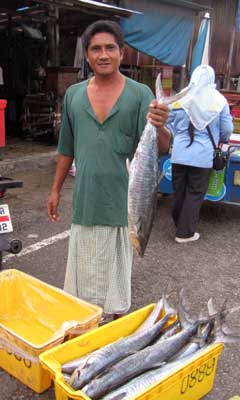
We were up early on Wednesday. It was a -would’ve - should’ve - could’ve- sort of a day. What I discovered Tuesday was that there were not direct buses to Narathiwat. We had to go to Hat Yai. I heard the desk clerk at our hotel say Hat Yai was half an hour away. I must have heard wrong, because it was an hour and a half. We expected buses to leave every two hour down the cost, but that info was wrong. The only buses leaving were VIP buses, which we did not want to wait for or pay for. Finally, we were told that there was a train to Narathiwat. We got a lift to the train station, and discovered that the train went to a town some twenty kilometers from Narathiwat. The train was super cheap and the people on the train were kind and interesting. It took nearly all day to go the 160 kilometers the crow would have flown to Narathiwat, and we probably covered 250 kilometers on the ground. We could see a very large military presence on the journey. There is a guerrilla insurgency in the area and eight people were slaughtered by them just a few days ago while they traveled in a minivan. To say the least, I was apprehensive, but the soldiers helped allay my fears a bit.
On the songthaew ride into Narathiwat we saw one of the largest sitting golden Buddha that I could imagine. It is just a few kilometers to the southwest of Nara. The town was not nearly as nice as Songkhla, but the people are the friendliest that we have met since leaving China. People were calling hellos to us all over the place. Had we known about all the transportation problems and what was to be seen in Nara, we would have gone directly to Malaysia. Still it was an interesting day, frustrating at times and fun at times too.
I saw most of the town when searching for a hotel. The selection is not great. After checking in, we walked up to the fishing village near the Hat Narathat beach, less than one kilometer to the north. We had expected to find some restaurants, but only found children playing soccer and other sports. They were all so friendly, asking us questions about whom we were and where we were from. It was great, save the light rain that came intermittently. We stayed a while then walked back into to town. Ordering food was a problem as the menus are only in Thai and they did not have photographs.
Today, Thursday the 22nd of March, was our last day in Thailand. We had less than 65 kilometers to travel as the crow flies. We found no buses that would go to Tak Bai and then the five kilometers more to the border at Ban Taba. We walked to the south side of town. Betty seemed to waiver as she sweltered in the heat. We stopped a few times to get oriented and rest in the shade. When we finally got to the right road, we quickly got a songthaew for 30 baht each. The woman who sat next to us was also going to Malaysia, so we followed her all the way. She was another wonderful person from the south of Thailand who was so friendly. The river is less than 200 meters wide and our boat crossed in a few minutes. Immigration on both sides was a breeze. We found a bus into Kota Bhuru for less than one dollar each. The bus took us to the center of the city and we began our search for a hotel. I will write more about Malaysia in my next entry.
Some closing thoughts on Thailand:
Thailand is the most developed country in Southeast Asia - at least - so far. It has a great infrastructure. It is only slightly more costly that the rest of Southeast Asia. The internet has high quality high-speed connections to the web. We really loved Chiang Mai and we like it here in the deep South. Chiang Mai was especially great, because we were able to hook up with Alan Puzey. Knowing a special person in a special place can make it even better. You can have Bangkok and the fancy Western beach resorts like Ko Samui. When we got away from the rest of the Western tourist areas, we found the people to be very friendly. When we return to Thailand, we will want to stay mostly in the northern provinces. It is hard to say whether or not it was our favorite country in Southeast Asia so far, because Vietnam rates fairly high up there, too.
March 16, 2007
Ko Phangan: Paradise Lost?
The Trip from Vientiane to Ko Phangan:
We planned to go to the south of Thailand after leaving Vientiane. It was a rather grueling journey. We got a tuk-tuk to the bus station and bought tickets to the town, Nong Khai, some 30 kilometers to the southeast on the other side of the friendship bridge. It cost less than two dollars and the bus was one of those beautiful Thai buses. In Nong Kai we got on the next bus to Bangkok. The bus was not as nice as the first one, but it only cost about $10 each to travel the 600 kilometers to Bangkok. We arrived about 10:30 at night. Betty had the bright idea to go right to the airport and catch the first flight out in the morning. We waited for a local bus to take us there, but it never showed up. We shared a cab to travel the 50 or 60 kilometers to the airport; our part was $5. When we got there we discovered that the cheap flight to Ko Samui, the bigger island just south of Ko Phangan was full so we ended up paying a lot more. We waited at the airport all night and enjoyed the free WiFi. At 6:15 we boarded and were off the ground 15 minutes later. We landed about 7:15 and went right to the pier to board a catamaran to Ko Phangan. Now it was about 9:00 AM, more than 26 hours after we started.
I have written a fuller description of the island below. Be sure to take a look at it.
Kicking Back in Ko Phangan
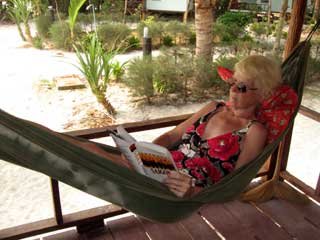
We ended up staying a week on the westside of Ko Phangan. We walked about a mile to find a beach bungalow about a mile from the pier. I booked one night. We thought we would go further afield the next day. We were just thirty feet from the water’s edge at a cost of $10.50 per night. We napped after our 24 plus hour journey. Then in the late afternoon we walked back to Song Thala. For the second time I tried to find someone that would rent a motorbike without surrendering my passport, which proved fruitless. There was an open food market with twenty or more food vendors, selling everything from fruit shakes to stir-fried noodles. We ate well. We walked back to our bungalow. The owner was anxious to know if wanted to spend another night. We thought and thought. Finally we figured it would be easier to take the whole next day searching, because of 10 AM checkout times on this island. I mentioned that we would want hot water to make tea and coffee in the morning. She said “No way,” because she sold tea and coffee. I gave the look that said “you got to be kidding.” She suggested that we get out the next day. This was the second sign that this was no paradise.
Early the next morning we hiked another kilometer or so down the road. After checking several, resorts we settled on Sabai Beach Resort. It cost less, at $9 per night, and their restaurant seemed good. We enjoyed the day in the sun and surf. Being further away from town, we ate at their restaurant. All was good. Then we went to bed and it was not so good. It was the hardest bed we had come across since coming to Asia. It was hardly more than a lightly padded board.
The next day I left Betty to enjoy the surf and I headed north walking and hitchhiking in search of a better bed. I looked from the Sritanu Bay to Hadd Yao. Sritanu is about three kilometers northwest of Sabai Beach and Hadd Yao is about six northwest. The beach was better in both places, with prices better in Sritanu. The entire stretch between the two locations was loaded with resorts and a village along the road. I decided upon The Beach resort in Sritanu Bay. I arrange for a pickup the next morning. Back at Saibai Beach, I got re-hydrated and enjoyed a wonderful sunset.
When checking out of the Sabai, I mentioned how much we enjoyed the resort – save for two things. The owner immediately wanted to know what those things were. First there was the bed, and then there was the 10 baht charge (30¢) for a cup of hot water. She must have heard about the hard beds before, but she got all pissed off about the hot water. The nickel and dime chiseling from the resort owners just pisses us off, but I have come to expect it in Thailand. So, I usually do not make a big deal about it – but I usually mention it. The response is always the same: false sorrow or defensiveness. I guess most of them have never traveled anywhere else. See some more comments below.
We got into a nice groove in Sritanu Bay. The bed was hard but did not cause our bones to ache. The beach was broad and smooth. No, it is not as nice as Hadd Yao, but it still is great. The season is winding down so many of the resorts are only half full. There are plenty of bungalows available from $6 to $9 per night. We even found a good little restaurant, the Ladda, where we eat our evening meals. Swimming, sunning, drinking, playing cards and meeting fellow travelers made up our four days in Sritanu Bay. We thoroughly enjoyed the place; its sights, sounds, smells and people. From its very hot afternoons to its warm balmy night it was great. Betty especially seemed to revel in it, while I was a bit more bored.
Paradise? The Way I See It Is . . . . .
Ko is the Thai word for island. Ko Phangan is not very large, maybe 20 kilometers from one side to the other. The interior is very hilly and forested. The beaches are very good, but not very broad in most places. The sand is white and smooth. The west side waters are very shallow, where you can walk out a hundred meters in places. The roads are winding and mostly concrete. They say that the best beaches are near the south tip and that is where it is most developed. That area has a heavy-duty party-hardy reputation. Some would call this a tropical paradise, and that it would be without all the people. There are truly beautiful sunsets along the west coast.
The typical accommodations are beachfront bungalows, so tiny that there is not much room left over for a single double bed. The bungalow is cooled with a fan and there are electric lights, too. There is a bath that has a shower with unheated water and a toilet that may have a flush mechanism and may not – in which case you have to dump the water in the pot. These bungalows cost from $6 to $18 per night. It is possible to get better and worse, which cost more – from $35 to $60 - and less as low as $4 per night. The low-priced ones are made of straw or thin boards and the better ones are concrete with thatched, or metal roofs. All in all the accommodations are fairly priced save for the fact that they do not provide drinking water, they do not provide boiled water, they may not even provide toilet paper and soap. Sometimes the beds are so hard that you might as well be on the floor. So careful checking before checking in is essential here.
In the towns good, cheap Thai food is available. There are 7-11’s which offer the best prices for beer and water, et al. Thong Sala has a great area with dozens of food stands set up where one can eat for about the same as any other place in Thailand. But the little stores, restaurants and the “resort” restaurants here will cost you up to twice as much as the rest of Thailand. Still a person can eat well for less than $12 per day. Drinks are a bit more expensive, but surprisingly enough beer is not any more expensive than the rest of Thailand at about $2 for a large, 24 ounce or 650 ml, bottle. Oh, have I mentioned before that in general beer is more expensive in Thailand than any other place in Asia. Considering that this is an island and the tourists are trapped and that there seems to be a lot of price fixing here, I think that the food is not overly priced.
Transportation is where paradise turns into its opposite. The locals say that there are taxis here, but there are no taxis on the island. There are no buses on the island. There are no regularly routed vans rolling around the island. There are not moto-taxis. So, how does one get around? In the rest of Thailand they call them songthaews. A songthaew is a small pickup truck with a soft room in the back and open sides with a bench running along each side. Most places in Thailand you can go a good long ways in one for 50 cents. Here on Ko Phangan they are insanely expensive and there appears to be not only price fixing among the operators but with the resorts, which push you into using them. So, how expensive are they? They want from $4.50 to $9 per person to go 2 to 15 kilometers. I almost left the island ten minutes after arriving, because I can not tolerate such unscrupulous behavior. One can rent a motorbike here. This is the best way to get around, however, all rental places insist on you leaving your passport. Something I would never do. If you are able to surrender it to someone you don’t know, then you can rent a bike for $4 to $6 per day. The only way to get to a resort is to arrange a pickup, which they will do, if you promise to book in. When getting back to the port, once again you are at the mercy of the songthaew mafia. Since the bulk of the tourists coming here could careless about this, it is unlike to change.
No, Ko Phangan is not paradise, unless you call a low-priced beach bungalow with plenty of pot to keep you mellow paradise. It is a place where folks are trying to make the most out of the travelers that journey here. The island’s solution to all problems appears to be collusion with prices fixed on almost everything: like $1.90 per hour on the internet – or $1.20 per kilo to get you clothes washed. They could make the island more inviting with a few simple changes, but they have not figured it all out yet. Just having simple regular – say hourly - songthaew service along the coast roads for 30 baht (90¢) would be a step in the right direction. Given the short distances this would still be a hefty fare, but this small concession is highly unlikely. Ko Phangan has lost paradise. Ko Phangan is another place despoiled by the tourists and that has been transformed into one of the hundreds of resort island resort that can be found around the world. We travelers seem to turn everything into stone. A pity and I am sure that I am part of the problem. For this I have no excuses; I cannot help myself; the wanderlust is too great. As far as Ko Phangan is concerned, I will never return to this island, nor can I recommend it to anyone.
To view a slideshow from southern Thailand, press HERE.
March 09, 2007
Nine Days in Laos
Day One on the Mekong 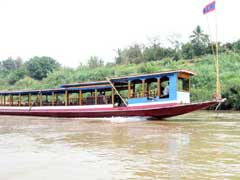 |
Day Two on the Mekong 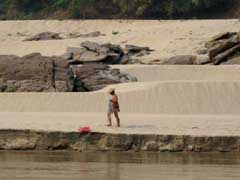 |
Sunset Over the Mekong 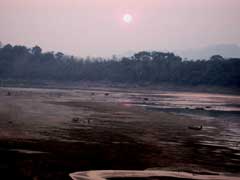 |
Luang Praban: City Sights  |
Sunset the Sacred Hill - Phousi 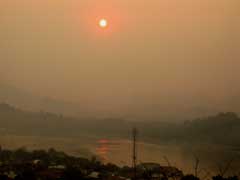 |
Phra-Lak Phra-Lam Cast 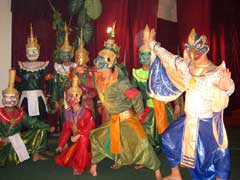 |
Rickety Bridge in Vang Viang  |
Victory Arch: Vientiane  |
Wednesday, 28 February:
It cost about $36 each for our van and boat rides to Laos, which included several meals and one nights lodging on the Thai side. It did not include the Lao visa. The company made us pay another $ 49.50 each. At the boarder we discover that the company had cheated us, as the visa only costs $ 35. We would expect to pay a $2 to $3 service fee beyond that, but no mater how you cut it they cheated us out of more than $20. We are hoping that our friend Alan will turn them into the tourist police when he returns.
Despite this financial snafu, almost every other part of the journey was enjoyable and went smoothly. We traveled by van to Chiang Khong and spent the night in a guesthouse. We were served both a buffet dinner and breakfast. Chiang Khong is a very little village. We walked around a bit on Wednesday night.
Marijke, Alan and Betty in Chiang Khong

March First:
Thursday morning we took a ferry across the Mekong River to Houeixai, Lao People’s Democratic Republic. After immigration, we were taken to another boat landing and got aboard boat 53. We departed about 11:30 and traveled on this long narrow boat for seven hours. The scenery was wonderful from glorious rock formations to Laotians working, swimming and playing in and around the river. At least four times Thursday and even more times on Friday, I saw women panning for gold along the river banks. As the sun was about to set we landed in Pakbeng for the evening. We had booked a room before leaving Houeixai that turned out OK but not great, mainly because there was not electricity hooked up to the water heaters – which means there were no showers that night or the next morning.
Friday morning we were back on the river, this time on boat 23. It left at 9:30. Like the day before we got a chance to meet many westerners on the boat. We spent a long time talking to Dani and Mike from Austria. They have been traveling for a year, taking sabbaticals from their fresh water biologist jobs. I am always on the look out for Danes and had seen almost none in Asia. Surprisingly enough, there were more than a dozen on the boat. They were mostly women who were about to enter the university. We talked with one a lot but did not get her name. I hope she writes us. The young Brits were hoisting beer after beer both days. The second day the boat ran out of beer twice. The beauty of the Mekong was just as evident the second day as the first. We arrived in Luang Praban just before dark, and set out looking for a guesthouse. The one that we got into was nice but expensive compared to the rest of SE Asia. Still it was only $15 per night. The four of us looked the next day for two nice rooms in the same guesthouse. The more we looked the more we realized that we had gotten excellent value for our money, because $15 was cheap compared to the rest of the town. In the evening we enjoyed the sights and the sounds of the night market with some of the best handicrafts in all of SE Asia. We had Indian food that was excellent.
Saturday in Luang Praban:
Several times since entering Laos, we had disagreements about the exchange rates, because we were using Thai baht and US dollars. Restaurant owners wanted to take an extra bite when paying with dollars and it was worse with baht. Never before had we experienced this sort of behavior. At breakfast that morning we ran into the problem again, even when the price was posted in dollars. So, one of the first things that we did was change money. The banks here were also taking a very large bite. The exchange rate on the international market is about 10,070 kip to the dollar, but the bank was offering only 9,620. Worse yet was what they would give for Thai baht. They should be offering 300 kip to the baht, but they only offered 270. The good thing about having made the exchange was that there would be no more quibbling about the rates.
Betty and I wandered around the town. We found several lovely spots to enjoy the feel of the place. Luang Praban is a very nice old and little city. The children play on the sand flats along the Mekong or in the cleaner other river where they can swim and play in the water. In the evening we enjoyed the sunset along the Mekong. The red orb was brilliant. It left a wonderful reflection on the Mekong.
Grilled Fish and Chicken at the Night Market

Sunday was another relaxing day. We spent the whole day walking along the edges of the two rivers. At 4:30 we met up with Alan and Marijke. We climbed the 328 step to the little temple on the Mount Phousi that overlooks the city. The view was great. And we waited here until the sun was again very low in the sky. I should mention that Phousi is pronounced just like Alan’s last name, Puzey. He likes to think of it as his mountain. We walked down to the river for a bite to eat and some beer. We walked back through a street littered with food sellers. They seemed to have everything. We got a chicken leg along the way.
Monday was a day of getting it together to move on. We got bus tickets south for our next stop. We also got tickets for the Royal Palace Museum Theater to see Phra-Lak Phra-Lam, a folkloric ballet and music show. After we got the tickets we had lunch and played cards and enjoyed some time by the river where we always try to have a pineapple shake.
The ballet was much better than anything we have seen thus far, even better than the shows that we saw in China. The actors and dancers were very young, some were children. The musicians were good. The singers were older and sat with the folk orchestra and sang with a PA system. We enjoyed it a lot. After the show, we met Alan and Marijke for a meal of Indian food, which I enjoyed and Betty tolerated.
Tuesday we were off to Vang Viang, which is half way to Vientiane. The road is very, very winding. You have to hang on to your stomach most of the way. The hills and the villages that we saw were beautiful, but they also showed how horridly poor this country is. I am not sure how many road miles we covered in our six hours to Vang Viang. We only stayed in the village the one night. There is a little river that runs through it. Many backpackers stop to enjoy a day of tubing on the river or to hike to the many caves in the hills around the village. The place is cheap, slow moving and easy to get into. Maybe we should have stayed longer.
Wednesday we were off to Vientiane. The journey was much shorter than the previous day. We booked into a guesthouse and rested a while. Then we walked down to the Mekong to have some beers and enjoy the sunset. The river is quite low this time of year with large stretches of sand exposed. After the sun went down we headed back to our room, stopping only for a light dinner of a spicy cucumber salad and Phad Thai, one of our favorites.
We got a late start on Thursday, I had not been feeling well and I wanted to take it easy. In the afternoon we saw a few of the major sites of the city. At Haw Pha Kaew we saw some old Buddhist art. This was the sight of where the Thais took the emerald green Buddha, which was taken when they ransacked the city in the 1800’s. Then we visited wat Sisaket, the wat of ten thousand Buddhas. Since most of the Buddhas were very small, it is quite possible that all ten thousand are there. Then we walked up to the Arch of Victory, which is Lao’s version of the Arc de Triomphe.
My impressions of the city are very positive. There are broad streets with wide uncluttered sidewalks. Trees line the boulevards. The food is good the place is small, slow and seems comfortable. But, like Luang Praban, there is not much to do here.
Tomorrow we will go back to Thailand after ten days in Laos.
Warning Sign in Luang Praban



